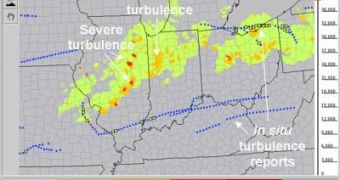Air turbulence has caused by now at least 509 airplane accidents in the US and 251 deaths. Annually, there are over 1,000 minor turbulence-related injuries on commercial aircrafts. Airlines lose each year millions of dollars due to injury claims, delays, extra fuel costs and aircraft damage, linked to turbulence.
But a novel turbulence detection system could alert in real time pilots as they fly through clouds.
The system was made at the National Center for Atmospheric Research (NCAR) and had good results when tested by United Airlines on commercial flights, being aimed to protect better passengers from injuries provoked by turbulence while decreasing flight delays and aviation costs.
It employs a mathematical formula developed by a NCAR team, called the NEXRAD Turbulence Detection Algorithm (NTDA), to transform information received from the National Weather Service's network of Next-Generation (NEXRAD) Doppler radars, delivering real-time snapshot of turbulence to pilots in the cockpit and also to airline meteorologists and dispatchers through a Web-based display.
"Pinpointing turbulence in clouds and thunderstorms is a major scientific challenge. Our goal is to use these radar measurements to create a 3-D mosaic showing turbulence across the country that can help pilots avoid hazardous areas, or at least give them enough warning to turn on the 'fasten seat belt' sign." said NCAR researcher John Williams.
The system is being tested until October by pilots of United Airlines making routes east of the Rockies.
"The messages I've received in the cockpit gave a very accurate picture of turbulence location and intensity. The depiction of turbulence intensity provides an unprecedented and extremely valuable new tool for pilot situational awareness." said Captain Rocky Stone, chief technical pilot for United Airlines.
The final results could lead to the expansion of the system to additional United aircraft or other airlines.
"By 2011, the NTDA will provide input to a system over the contiguous United States that will update comprehensive turbulence "nowcasts" for pilots and air traffic managers every 15 minutes. We hope this will provide a significant boost to the aviation industry in terms of passenger comfort, safety, and reduced costs," said Williams.
The lack of precise measurements of turbulence developed in clouds and thunderstorms, due to the small areas of the turbulence, rapid evolution and turbulence's location outside the most intense area of the storm, made in the past pilots to avoid thunderstorms by at least 20 miles (12 mi), even if large areas around could be relatively calm.
The NTDA detects turbulence in storms by peering into clouds to register the winds' distribution. While processing the data, it removes contaminant factors like sunlight, nearby storms, or even insect swarms flying close to the radar dish, while other measurements increase the reliability of its turbulence estimates.
The system had successfully forecast moderate-or-greater turbulence in over 80 % of the time in 2005-2006, but now the NTDA is greatly improved.

 14 DAY TRIAL //
14 DAY TRIAL //